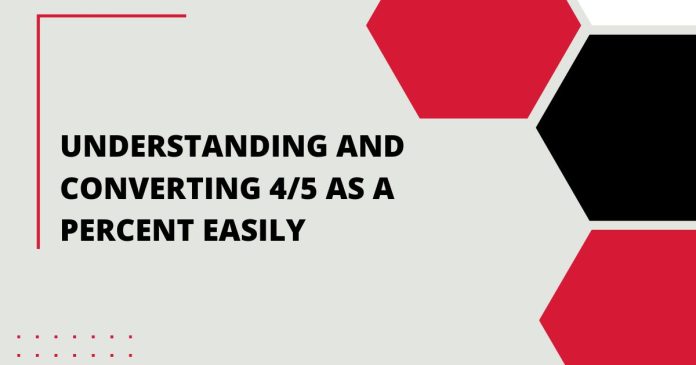In the realm of mathematics and everyday calculations, fractions and percentages often come into play. These concepts are essential for a variety of applications, ranging from academics to finance. One common question that arises is how to express the fraction 4/5 as a percent. In this article, we will delve into the steps required to effortlessly convert the fraction 4/5 to a percentage. So, let’s jump right in!
Table of Contents
- Introduction
- The Basics of Fractions and Percentages
- Converting 4/5 to a Decimal
- Transforming a Decimal into a Percentage
- The Shortcut Method: Direct Conversion
- Real-life Applications of Converting Fractions to Percentages
- Practice Makes Perfect: Examples for Mastery
- Overcoming Common Challenges
- Tips and Tricks for Mental Calculation
- Embracing Technology: Conversion Tools
- Conclusion
- FAQs
Introduction
Fractions are a fundamental concept in mathematics that represent parts of a whole. On the other hand, percentages convey the proportion of something in relation to 100. Understanding the relationship between these two concepts can greatly aid in various calculations.
The Basics of Fractions and Percentages
Before we dive into converting 4/5 into a percentage, let’s establish a foundation. A fraction consists of a numerator (the top number) and a denominator (the bottom number). In the fraction 4/5, the numerator is 4, and the denominator is 5.
Percentages, on the other hand, are ratios expressed out of 100. For instance, 50% means 50 out of 100. As we aim to convert 4/5 to a percentage, we’ll determine the equivalent value out of 100.
Converting 4/5 to a Decimal
One intermediate step to converting fractions to percentages is representing the fraction as a decimal. To convert 4/5 to a decimal, simply divide 4 by 5. This gives us 0.8.
Transforming a Decimal into a Percentage
To proceed to the final step, we’ll transform the decimal into a percentage. This involves multiplying the decimal by 100. Therefore, 0.8 becomes 80%.
The Shortcut Method: Direct Conversion
While we have explored the step-by-step method, there’s a shortcut for converting fractions to percentages. For fractions with denominators like 5, 10, 25, and 50, you can often directly convert them. In our case, 4/5 translates to 80% without the need for decimal conversion.
Real-life Applications of Converting Fractions to Percentages
The skill of converting fractions to percentages finds use in various real-life scenarios. From calculating discounts during shopping to determining success rates in experiments, this skill is widely applicable.
Practice Makes Perfect: Examples for Mastery
To master this conversion, let’s work through a couple of examples:
- Convert 2/5 to a percentage:
- Step 1: Divide 2 by 5 to get 0.4
- Step 2: Multiply 0.4 by 100 to get 40%
- Convert 3/8 to a percentage:
- Step 1: Divide 3 by 8 to get 0.375
- Step 2: Multiply 0.375 by 100 to get 37.5%
Overcoming Common Challenges
Sometimes, fractions might not have denominators that fit the shortcut method. In such cases, using the step-by-step process becomes crucial. Practice and familiarity will lead to swift calculations.
Tips and Tricks for Mental Calculation
For quick mental conversions, it’s helpful to know common fractions and their percentage equivalents. For example, 1/4 is 25%, 1/2 is 50%, and 3/4 is 75%.
Embracing Technology: Conversion Tools
In today’s digital age, various online tools and calculators can swiftly perform these conversions. They’re especially handy for complex fractions and decimals.
Conclusion
Converting fractions to percentages, such as 4/5 to 80%, bridges the gap between two crucial mathematical concepts. This skill proves invaluable in practical scenarios and enhances our numeracy. By following the steps or utilizing shortcuts, we can effortlessly make these conversions and apply them effectively.
FAQs
Q1: Why is converting fractions to percentages important? A: Converting fractions to percentages allows us to express ratios in relation to 100, which is practical for a wide range of calculations.
Q2: Are there other methods for converting fractions to percentages? A: Yes, there are different methods, including the shortcut method for fractions with specific denominators.
Q3: Can I use a calculator for these conversions? A: Absolutely, calculators and online tools are excellent for quick and accurate conversions, especially for complex fractions.
Q4: What are some real-life examples of using this conversion? A: Examples include calculating discounts, exam scores, success rates, and ingredient proportions in recipes.
Q5: Where can I find more practice problems to enhance my skills? A: Various math resources, textbooks, and online platforms offer practice problems to help you sharpen your conversion abilities.

